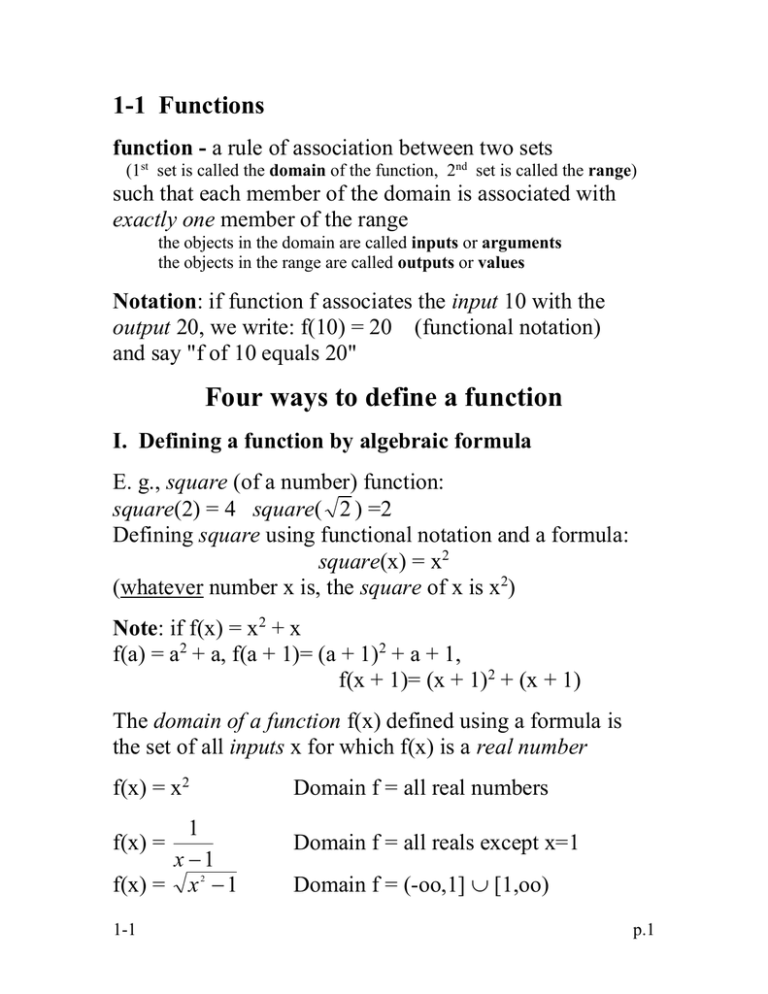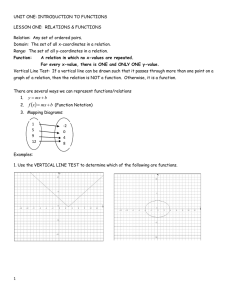Four ways to define a function 1-1 Functions
advertisement

1-1 Functions function - a rule of association between two sets (1st set is called the domain of the function, 2nd set is called the range) such that each member of the domain is associated with exactly one member of the range the objects in the domain are called inputs or arguments the objects in the range are called outputs or values Notation: if function f associates the input 10 with the output 20, we write: f(10) = 20 (functional notation) and say "f of 10 equals 20" Four ways to define a function I. Defining a function by algebraic formula E. g., square (of a number) function: square(2) = 4 square( 2 ) =2 Defining square using functional notation and a formula: square(x) = x2 (whatever number x is, the square of x is x2) Note: if f(x) = x2 + x f(a) = a2 + a, f(a + 1)= (a + 1)2 + a + 1, f(x + 1)= (x + 1)2 + (x + 1) The domain of a function f(x) defined using a formula is the set of all inputs x for which f(x) is a real number f(x) = x2 Domain f = all real numbers 1 x 1 f(x) = x 1 f(x) = 2 1-1 Domain f = all reals except x=1 Domain f = (-oo,1] [1,oo) p.1 II. Defining a function by mapping diagram mother(Sam) = Gertrude input: Sam output: Gertrude III. Defining a function by equation Example: function p defined by equation: y = x2 x represents (by convention) an input x is called the independent variable y represents an output - called the dependent variable p(0) = 0 p( 2 ) = 2 Some equations don’t define functions Example: y2 = 1 + x if input x = 3, output y could be 2 or -2 2 possible outputs for one input therefore, not a function 1-1 p.2 III. Defining a function by graph f as a mapping diagram (3, 9) (2, 4) (1, 1) 1-1 f as a graph: f(1) = 1, f(2) = 4 f(3) = 9 p.3 EXAMPLE: f(x) = x2 some input/output pairs: x 1 2 3 -1 f(x) 1 4 9 1 -2 4 -3 9 0 0 Graph the pairs, and fill in: Graph of f(x) = x2 the domain values are x-coordinates the range values are y-coordinates 1-1 p.4 When is a graph not a function? a function must associate with each number in its domain one and only one number in its range vertical line test: if a moving vertical line will cut a graph in more than one place, the graph does not represent a function 1-1 p.5 Summary: four ways to describe or define a function I. By formula: f(x) = x2 II. By mapping diagram: g 1 1 2 3 4 III. By equation: the function f defined by the equation: y = x2 III. By graph: 1-1 p.6 Label and scale your graphs! Guidelines for "label and scale": (1) both axes must be labeled according to the names of the variables given by the problem: independent variable on the horizontal axis dependent variable on the vertical axis (if the graph is the graph of a named function, there is no dependent variable; instead, the name of the function can be used; e.g. "f(x)", as shown above) (2) scaling should be done so as to convey the sense of scale of the graph without overly cluttering it: if the scale goes from 1 to 100, don't draw in 100 ticks and label each one usually, 2-10 scale ticks, with 2-3 of them labeled, will convey the scale, as shown above 1-1 p.7



